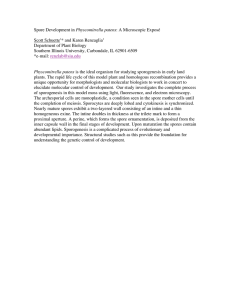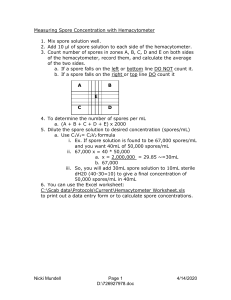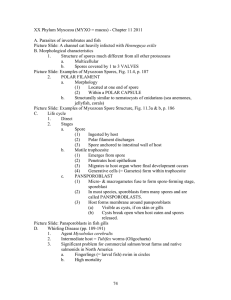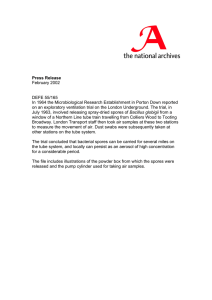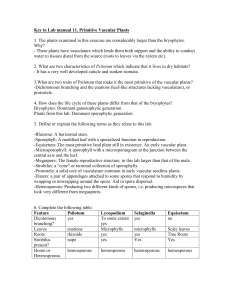The Microsporidian Spore Invasion Tube. IV. Discharge Activation
advertisement
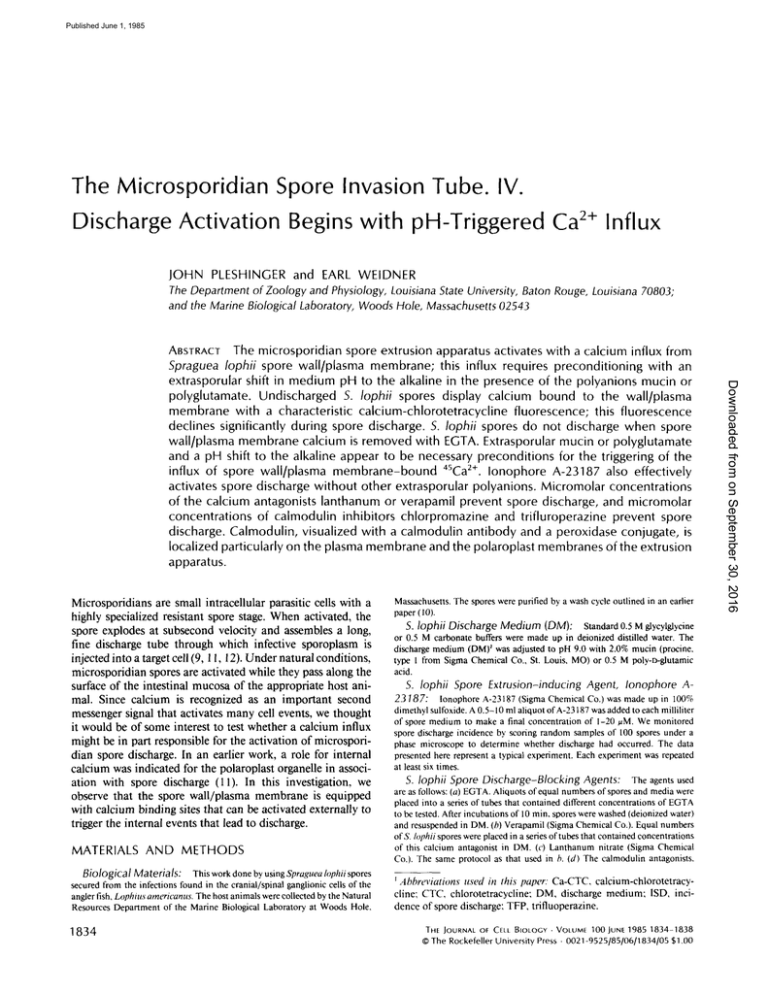
Published June 1, 1985 The Microsporidian Spore Invasion Tube. IV. Discharge Activation Begins with pH-Triggered Ca 2+ Influx JOHN PLESHINGER and EARL WEIDNER The Department of Zoology and Physiology, Louisiana State University, Baton Rouge, Louisiana 70803; and the Marine Biological Laboratory, Woods Hole, Massachusetts 02543 Microsporidians are small intracellular parasitic cells with a highly specialized resistant spore stage. When activated, the spore explodes at subsecond velocity and assembles a long, fine discharge tube through which infective sporoplasm is injected into a target cell (9, 1 l, 12). Under natural conditions, microsporidian spores are activated while they pass along the surface of the intestinal mucosa of the appropriate host animal. Since calcium is recognized as an important second messenger signal that activates many cell events, we thought it would be of some interest to test whether a calcium influx might be in part responsible for the activation of microsporidian spore discharge. In an earlier work, a role for internal calcium was indicated for the polaroplast organelle in association with spore discharge (1 l). In this investigation, we observe that the spore wall/plasma membrane is equipped with calcium binding sites that can be activated externally to trigger the internal events that lead to discharge. MATERIALS AND METHODS Biological Materials: This work done by using Spraguea lophii spores secured from the infections found in the cranial/spinal ganglionic cells of the angler fish, Lophius americanus. The host animals were collected by the Natural Resources Department of the Marine Biological Laboratory at Woods Hole, 1834 Massachusetts, The spores were purified by a wash cycle outlined in an earlier paper (10). S. Iophii Discharge Medium (DM): Standard0.5 M glycylglycine or 0.5 M carbonate buffers were made up in deionized distilled water. The discharge medium (DM) ~ was adjusted to pH 9.0 with 2.0% mucin (procine, type 1 from Sigma Chemical Co., St. Louis, MO) or 0.5 M poly-D-glutamic acid. S. Iophii Spore Extrusion-inducing Agent, Ionophore A23187: lonophore A-23187 (Sigma Chemical Co.) was made up in 100% dimethyl sulfoxide. A 0.5-10 ml aliquot of A-23187 was added to each milliliter of spore medium to make a final concentration of 1-20 uM. We monitored spore discharge incidence by scoring random samples of 100 spores under a phase microscope to determine whether discharge had occurred. The data presented here represent a typical experiment. Each experiment was repeated at least six times. S. Iophii Spore Discharge-Blocking Agents: The agents used are as follows: (a) EGTA. Aliquots of equal numbers of spores and media were placed into a series of tubes that contained different concentrations of EGTA to be tested. After incubations of 10 rain, spores were washed (deionized water) and resuspended in DM. (b) Verapamil (Sigma Chemical Co.). Equal numbers ofS. Iophii spores were placed in a series of tubes that contained concentrations of this calcium antagonist in DM. (c) Lanthanum nitrate (Sigma Chemical Co.). The same protocol as that used in b. (d) The calmodulin antagonists, f Abbreviations used in this paper." Ca-CTC, calcium-chlorotetracycline; CTC, chlorotetracycline; DM, discharge m e d i u m ; ISD, incidence of spore discharge: TFP, trifluoperazine. THE JOURNAL OF CELL BIOLOGY • VOLUME 100 JUNE 1985 1834-1838 © The Rockefeller University Press • 0021-9525/85106/1834105 $I .00 Downloaded from on September 30, 2016 ABSTRACT The microsporidian spore extrusion apparatus activates with a calcium influx from Spraguea Iophii spore wall/plasma membrane; this influx requires preconditioning with an extrasporular shift in medium pH to the alkaline in the presence of the polyanions mucin or polyglutamate. Undischarged S. Iophii spores display calcium bound to the wall/plasma membrane with a characteristic calcium-chlorotetracycline fluorescence; this fluorescence declines significantly during spore discharge. S. Iophii spores do not discharge when spore wall/plasma membrane calcium is removed with EGTA. Extrasporular mucin or polyglutamate and a pH shift to the alkaline appear to be necessary preconditions for the triggering of the influx of spore wall/plasma membrane-bound 45Ca2+. Ionophore A-23187 also effectively activates spore discharge without other extrasporular polyanions. Micromolar concentrations of the calcium antagonists lanthanum or verapamil prevent spore discharge, and micromolar concentrations of calmodulin inhibitors chlorpromazine and trifluroperazine prevent spore discharge. Calmodulin, visualized with a calmodulin antibody and a peroxidase conjugate, is localized particularly on the plasma membrane and the polaroplast membranes of the extrusion apparatus. Published June 1, 1985 trifluoperazine (TFP) and chlorpromazine (Sigma Chemical Co.). Stock solutions were made up in deionized water. The spores were immersed in a range of concentrations of these antagonists in deionized water for 5 min. After this incubation, spores were immersed in DM and after 5 rain, the spores were lightly fixed with glutaraldehyde, and the incidence of discharge was scored. Reversibility tests were done to determine whether the antagonists had a permanent effect on spore discharge. Spores were first immersed in antagonist medium (in distilled water) for 60 min, thoroughly washed free of antagonist with distilled water, and resuspended in DM. The incidence of spore discharge was then scored. Calcium Probe, Chlorotetracycline(CTC): S Iophiisporeswere RESULTS Microsporidian spore anatomy is presented as a background to our observations on the role of calcium and associated factors in spore discharge activation. The major parts of the spores of S. lophii are the sporoplasm, extrusion apparatus, and spore wall (Fig. 1). The sporoplasm is the infective cell that typically discharges with subsecond velocity after activation of the extrusion apparatus. The extrusion apparatus consists of an aperture, polar filament, membrane-rich polaroplast, and a posterior vacuole (Fig. l). Polyanions and oH on S. Iophii Spore Extrusion Spores of S. lophii discharged in glycylglycine or carbonate buffer during the switch from neutral (or acid) to alkaline pH in the presence of mucin or polyglutamate (Fig. 2). The polyanions and the shift to the alkaline pH were required protocol for spore discharge. No discharge took place when spores were immersed into medium with polyanions but at neutral pH. Conversely, no spore discharge occurred when spores were placed in alkaline medium without the polyanions polyglutamate or mucin (Fig. 2). CTC As a Probe for Membrane-associated Ca 2÷ during Spore Discharge Calcium-chlorotetracycline (Ca-CTC) fluorescence was apparent at the spore boundary before extrusion (Fig. 3 a). After discharge, much of this fluorescence was extinguished (Fig. 3, a and b). Spores pretreated with EGTA showed little Ca-CTC fluorescence. FIGURE 1 Thin section of 5. Iophii spore exhibiting membrane-rich polaroplast, polar filament, sporoplasm, and spore wall. x 60,000. PLESHINGERAND WEIDNER Activators of Microsporidian Spore Extrusion 1835 Downloaded from on September 30, 2016 placed in a medium with I-5 ul of freshly prepared unbuffered glucose with 2 mM CTC, yielding a final concentration of 100-150 ~M CTC. Spores were mounted on wet-mount slides and examined for fluorescence. Fluorescence was monitored with Leitz epifluorescence optics with oil at 1,200x (E. Leitz, Inc., Rockleigh, NJ). The CTC fluorescence was induced by light excitation from a mercury lamp, and emission was limited by a 520-nm barrier filter. Radiochromatography: Five controlled experiments (A-E) were performed with l0 g S. lophii spores in each. Spores were washed in deionized water before incubations. In experiment A, spores were immersed in 0.2 M cold CaCl2, washed in deionized water, and transferred to 0.5 ml of 4SCaCl_, that had a specific activity of 5.0 ~Ci for 10 min. In experiment B, spores were placed in 0.15 mM EGTA, washed in deionized water, and immersed with 4~CaCI2 that had a specific activity of 5.0 #Ci for l0 rain. In experiment C, spores were placed in 0.15 mM EGTA, washed in deionized water, and exposed to 4~CaCl2with 0.5/zl of 15 mM lonophore A-23187, but the spores remained undischarged since the medium was at pH 7.0. In experiment D, spores were treated with 0.15 mM EGTA, washed in deionized water, and placed in 0.5 ml of 45CaCb that had a specific activity of 5.0 uCi for l0 min, then in DM at pH 9.0 that contained 0.1 ul of ionophore A-23187 stock solution. The pH of 9 induced spore discharge in the presence of 45CaCl2. Experiment E was the same as D except that porcine mucin (0.2%) was used instead ofA-23187. The spores from experiments A-E were washed in deionized water and transferred to Millex (Millipore Corp., Bedford, MA) 0.22-um disposable filters. Circular cutouts (8.0 mm) of the filters were scanned with a 7230 radiochromatogram scanner (Packard Instrument Co., Inc., Downers Grove, IL). Immunoperoxidase: The binding of antibody to calmodulin was detected by using the indirect immunoperoxidase method described elsewhere (4). Spores were fixed for 5 min in 0.12 M cacodylate-buffered 0.5% glutaraldehyde and washed thoroughly. The frozen pellet was cryostat-sectioned at 5um thickness. This sectioned spore material was washed in Ringer's solution and immersed in sheep anti-calmodulin (provided by CAABCO, Inc., Houston, TX) diluted 1:25 in Ringer's solution and incubated at 30°C for 50 mira cells were washed in Ringer's solution at 4°C and exposed to rabbit anti-sbeep lgG conjugated to peroxidase (provided by Cappel Laboratories, Inc., Cochranville, PA) for 20 min, washed in 0.1 M cacodylate buffer, and fixed in 1.5% glutaraldehyde-buffered cacodylate (pH 7.2) for 45 rain. Cells were then washed in 0.1 M cacodylate buffer and exposed to diaminobenzidine working medium (1) for 15 min. The cells were washed in 0.1 M cacodylate buffer, postfixed in 1% osmium in distilled water, and processed for transmission electron microscopy. Published June 1, 1985 70 60 5O 40 ~ 3o 20 I0 C 5 6 7 s 9 io , pH FIGURE 2 Incidence of S. Iophii spore discharge (ISD) in buffer with polyanions as a function of pH. Spores suspended in glycylglycine buffer with 0.2% mucin ([3) or 0.5 M poly-g-glutamate (O) or without polyanions (A) at different pH val, ues. Results are reported as percent Iz 13 14spore discharge in buffer at given pH. did not increase when A-23187 was added to the medium with polyglutamate or mucin. S. lophii spores pretreated with CaCI2, washed in distilled water, and then incubated in 0.15 mM EGTA would not discharge when placed in DM with A23187. The calcium channel antagonist verapamil prevented S. lophii spore extrusion in DM at concentrations as low as 20 #M (Fig. 4); this apparent inhibition was reversed with verapamil removal (six washes in distilled water), spore incubation overnight in glycylglycine buffer at pH 7, and the spore immersion in DM (Fig. 4). Lanthanum, a noted Ca 2+ antagonist, prevented S. lophii spore discharge at concentrations of 50 and 100 ~M (Fig. 5); this inhibition did not occur when lanthanum was removed from the extrasporular medium and the spores were transferred to the standard DM (Fig. 5). Radiochromatography of 45Ca2+ Influx into S. Iophii Spores EGTA and Spore Discharge When spores were washed in 0.2 M CaCI2, rinsed thoroughly with distilled water, and immersed in DM (pH 9.0), a 70% frequency of spore discharge took place; however, when spores were immersed in CaCI2, washed in distilled water, and then transferred for 10 min in 0.07 mM EGTA, there was only a 5% incidence of spore discharge. No spore discharge occurred when the EGTA concentration was raised to 0.25 mM. When the EGTA-treated spores were then washed thoroughly in distilled water, incubated in glycylglycine buffer overnight (pH 7.0), exposed to CaC12, washed with distilled water, and immersed in DM, there was a return to normal spore discharge frequency. However, if the EGTA incubation was at concentrations above 0.15 mM, there was a reduced capability for spores to regain a discharge capacity. Activation of S. Iophii Spores with Ionophore A-23187 S. Iophii spores in glycylglycine buffer (0.1 M) with A23187 (but without polyanionic mucin or polyglutamate) showed a 70% frequency of spore discharge with a pH shift of the extrasporular medium to 9.0; however, the incidence of spore discharge remained near zero if the pH of the medium was kept at 7.0. Polyglutamate or mucin effected a similar 70% frequency of spore discharge; this discharge frequency 1836 THEJOURNAL OF CELL BIOLOGY • VOLUME 100, 1985 Calmodulin Inhibitors, Anti-Calmodulin, and S. Iophii Spore Discharge The calmodulin antagonists, TFP and chlorpromazine, were used to determine whether extrusion apparatus activaI0( 9E 8( 7'( 6( ~ sc ~ 4C 2C tC C -, FIGURE 4 Effects of verapamil on S. Iophii ISD. Spores activated to discharge with 0.2% mucin in [] [] [] glycylglycine buffer at pH 9.0 in different verapamil concentrations. Results displayed as percentage of discharged spores compared with control without verapamil (+). I-I, ISD after vera~o z0 ~o 40 ~o so re pamil removal from spore meVerapamil (p.M) dium and subsequent exposure to fresh DM (reversibility test). 100 90 [] 80 70 60 4O 3( IC CO i L i i t i i IO 2 0 ~ 1 0 4 0 5 0 6 0 7 0 8 0 9 0 LQNO3(FM) i i i IOO FIGURE 5 Effects of lanthanum nitrate on S. Iophii ISD. Spores activated to discharge while in different concentrations of lanthanum nitrate. Results show incidence of spore discharge as compared with controls without lanthanum (+). F1, ISD after LaNO3 removal and spore exposure to fresh DM (reversibility test). Downloaded from on September 30, 2016 FIGURE 3 Views of undischarged and discharged S. Iophii spores exposed to 100 ~M CTC. (a) Arrow on left indicates undischarged spore with CTC fluorescence confined to internal polaroplast region and spore wall/plasma membrane. Arrow on right shows significantly reduced CTC fluorescence in discharged spore. (b) Arrow on left indicates discharged spore CTC fluorescence. Arrow on right shows extruded sporoplasm, x 1,500. Calcium influx into S. lophii spores was monitored by radiochromatography. The A spores (which were not placed in DM and thus remained undischarged) were immersed in cold CaC12 and then transferred to 45CaCl:. These spores showed little 4SCa2+uptake (Fig. 6, A). The B spores, immersed in EGTA before 45CaC12 incubation, showed slight amounts of 45Ca2+ uptake (Fig. 6, B). The C spores were washed in EGTA, incubated in 45CaC12, and immersed in A-23187 but at a pH of 7 (therefore, the spores remained undischarged). The C spores showed a slight amount of 45Ca2+ uptake (Fig. 6, C). The D spores were washed in EGTA, incubated in 45CaC12 and transferred to A-23187 in DM at pH 9. These spores displayed a high level of discharge and showed a significant increase in the 45Ca2÷ uptake (Fig. 6, D). The E spores were washed in EGTA, incubated in 45CAC12, and induced to discharge with mucin in the extrasporular medium with a pH of 9. The level of incorporation of 45Ca2+ was similar to that observed for the D spores (Fig. 6, E). Published June 1, 1985 tion was calmodulin-associated. These phenothiazine derivatives significantly reduced the discharge capability of S. lophii spores at concentrations of 5-40 ~tM (Figs. 7 and 8). The phenothiazine-treated spores regained the capacity to discharge after the drug was removed from the extrasporular medium (by thorough washing in distilled water) and the spores were resuspended in fresh DM. However, incubations of the spores in 80 #M chlorpromazine had an obvious permanent negative effect on spore discharge; these spores showed little capacity to regain a discharge capability when the spores were washed and placed in DM (Fig. 8). Anticalmodulin and a peroxidase conjugate were used to visualize 25 2O x b5 .¢: ~E == o B b C c dE e 90 [] [] 80 70 o 60 SO 40 30 20 I0 0 i I i 2 , 3 , 4 , 5 i i 6 7 8 1 i i 910 TFP(p.M) 90 FIGURE 7 Effect of trifluoperazine (TFP) on S. Iophii ISD. Spores immersed in DM with different TFP concentrations. Results report ISD as compared with control samples without TFP (+)• 17, results of reversibility tests of TFP-inhibited spores washed and transferred to fresh DM without TFP. [] [] 7C o Immunoperoxidase labeling of cryostat-sectioned S./o- of two spores. Label is most apparent on the extrusion apparatus membrane (arrows). x 10,000. (b) A higher magnification of polaroplast component of extrusion apparatus showing apparent reaction to immunoperoxidase labeling, x 20,000. (c) Control showing absence of reaction to peroxidase without calmodulin antibody• x 25,000. the calmodulin within cryostat-sectioned spores. Presumptive anti-calmodulin peroxidase conjugates were mostly found near the membranes of the spore extrusion apparatus (Fig. 9, a and b). Control spores exposed to peroxidase but without anti-calmodulin showed no reaction (Fig. 9 c). [] 8C FIGURE 9 phil spores with anti-calmodulin antibodies. (a) A low magnification 6c ~so 40 30 20 I0 o [] ,o 2o~o~o5o6o~o 8o (/~M) FIGURES 8 Effect of chlorpromazine on S. Iophii ISD. Spores were immersed in DM with different chlorpromazine concentrations. Results report ISD as compared with control samples without chlorpromazine (+). i-I, results of reversibility tests of chlorpromazineinhibited spores washed and transferred to fresh discharge medium without chlorpromazine. Note that spores in 80/~M chlorpromazine did not respond well to reversibility test. Chlor promazine DISCUSSION The results indicate that three extrasporular conditions are required to activate S. lophii spore invasion tube discharge: (a) a pH shift from acid/neutral to the alkaline; (b) the presence of calcium bound to the spore wall/plasma membrane; and (c) the presence of polyanions (such as polyglutamate or mucin). The following evidence indicates that a calcium influx is a primary signal for S. lophii spore discharge. First, the calcium chelator EGTA blocked spore discharge; PLESHINGERAND WEIDNER Activators of Microsporidian Spore Extrusion 1837 Downloaded from on September 30, 2016 A FIGURES 6 Radiochromatogram scan of 4SCaCI2 uptake into S. /ophii spores. The A spores were exposed to CaCIz, washed in deionized distilled water, and incubated in 4SCaCI2; the B spores were treated with EGTA, washed, and incubated in 4SCaCI2; the C spores were treated with EGTA, washed, and incubated in 4SCaCI2 with A-23187 at pH 7; the D spores were pretreated with EGTA, washed, incubated in 4SCaCI2 with glycylglycine buffer with A23187 at pH 9; and the E spores were pretreated with EGTA, washed, and incubated in 4SCaCI2 with glycylglycine buffer with 0.2% mucin at pH 9. Counts of final wash supernatant for each sample are depicted in a-e. Published June 1, 1985 1838 THE JOURNAL OF CELL BIOLOGY • VOLUME 100, 1 9 8 5 tine. The mucin may create an ion exchange phenomenon during the shift of the extrasporular medium from acid/ neutral to alkaline pH. Such a phenomenon fits the Spray et al. model for the triggering of the opening of calcium channels in plasma membranes (8). This model indicates that under low free hydrogen conditions (alkaline), calcium channels are open; however, a shift to a free hydrogen medium (slightly acid) closes the calcium channels. Perhaps the polyanions in the extrasporular environs create a buildup in the ion potential so that when a pH shift to the alkaline occurs, a sudden influx of calcium with the opening of the channels is permitted. Examples of cationic influxes are believed to be common phenomena along the mucosal surface of the intestine (7). Received for publication 4 October 1984, and in revised fi~rm 4 January 1985. REFERENCES 1. Graham, R. C., and M. J, Kamovsky. 1966. The early stages of absorption of injected horseradish peroxidase in the proximal tubules of mouse kidney. Ultrastructural cytochemistry by a new technique. J. Histochem. Cytochem. 14:291-302. 2. Hagiwara, S., and L. Byerly. 1981. Calcium channels. Annu. Bey. Neurosci. 4:69-125. 3. Levin, R. M., and B. Weiss. 1979. Selective binding of antipsychotics and other psychoactive agents to the calcium-dependent activator of cyclic nudeotide phosphodiesterase..L Pharmacol. Exp. Ther. 208:454-459. 4. Louvard, D., H. Reggio, and G. Warren. 1982. Antibodies to the Golgi complex and the rough endoplasmic retieulum..L Cell Biol. 92:92-107. 5. Nachshen, D. A., and M. D. Blanstein. 1979. Effects of some organic Ca 2+ antagonists in calcium influx. Mol. PharmacoL 16:579-586. 6. Rouogalis, B. D. 1975. Comparative studies on the membrane actions of depressant drugs: the role of lipophilicity in inhibition of brain sodium and potassium stimulated ATPase. J. Neurochem. 24:51-61. 7. Schauer, R. 1982. Chemistry, metabolism and biological function of sialic acids. Adv. Carbohydr. Chem. Biochem 40:131-234. 8. Spray, D. C., A. L. Harris, and M. V. L. Bennett. 1982. Comparison ofpH and calcium dependence of gap junction and conductance. In Intracellular pH: Its Measurement, Regulation, and Utilization in Cellular Reactions. R. Nuccitelli and D. W. Deamers, editors. Alan R. Liss, Inc., New York. 445-46 I. 9. Weidner, E. 1972. UItrastructural study of microsporidian invasion into cells. Z. Parasitenkd. 40:227-242. I0. Weidner, E. 1976. The microsporidian spore invasion tube. The ultrastructure, isolation. and characterization of the protein comprising the tube..L Cell Biol. 71:23-34. 11. Weidner, E., and W. Byrd. 1982. The microsporidian spore invasion tube. 11. Role of calcium in the activation of the invasion tube discharge. ,L Cell Biol. 93:970-975. 12. Weidner, E., W. Byrd, A Scarborough, J. Pleshinger, and D. Sibley. 1984. Microsporidian spore discharge and the transfer of polaroplast organelle membrane into plasma membrane. £ Protozool. 31:208-213. 13. Wolniak, S., P. K. Hepler, and W. T. Jackson. 1980. Detection of the membranecalcium distribution during mitosis in Haemanthus endosperm with chlorotetracycline. Z Cell Biol. 87:23-32. Downloaded from on September 30, 2016 the CTC fluorescence studies indicate that the EGTA removed the bound Ca 2÷ from the spore wall/plasma membrane. The work of Wolniak et al. indicates that Ca-CTC fluorescence is clearly distinctive when associated with hydrophobic regions (13). Secondly, A-23187 induced a C a 2+ influx immediately before spore discharge. The following evidence supports Hagiwara and Byerly's criteria for possible calcium channels in S. lophii plasma membranes: (a) The organic channel antagonist verapamil strongly blocked S. lophii spore discharge at concentrations typical for inhibiting calcium channels (2, 5); as expected, the verapamil-treated spores could effectively activate and discharge after the removal of the verapamil. (b) The inorganic channel antagonist lanthanum blocked S. lophii spore discharge. The lanthanumblocked spores still could be activated and discharged after removal of the lanthanum from the extrasporular medium. (c) Finally, the phenothiazine inhibitors calmodulin, chlorpromazine, and TFP also blocked spore discharge. These antagonists have a strong affinity for calmodulin (3). The interference caused by the phenothiazines may be due to their hydrophobic affinities; however, it is unclear whether the blocking action is due to a binding to the specific ports in the membrane, or whether the molecules complex directly with the hydrophobic regions on the calmodulin molecule (3, 6). The anti-calmodulin peroxidase conjugates seem to indicate that calmodulin is in the vicinity of the spore extrusion apparatus membrane. The evidence indicates a good probability for a calcium-calmodulin mediated system involved in the initiation of spore discharge. Polyanions are likely involved in the activation of the calcium influx into S. lophii spores. The sialic acid residues on the mucin molecule may be partly responsible for effecting spore activation since other anionic groups (such as polyglutamate) also affect the triggering of the calcium influx. Indeed, substrate-associated SiO3- groups on the surfaces of glass slides could activate S. lophii spores charged with calcium and shifted to an alkaline pH; this activity was reduced to zero when the slide surface was covered with polylysine. Probably mucin serves as a natural stimulator for S. lophii spore discharge along the mucosal lining of the host animal intes-
